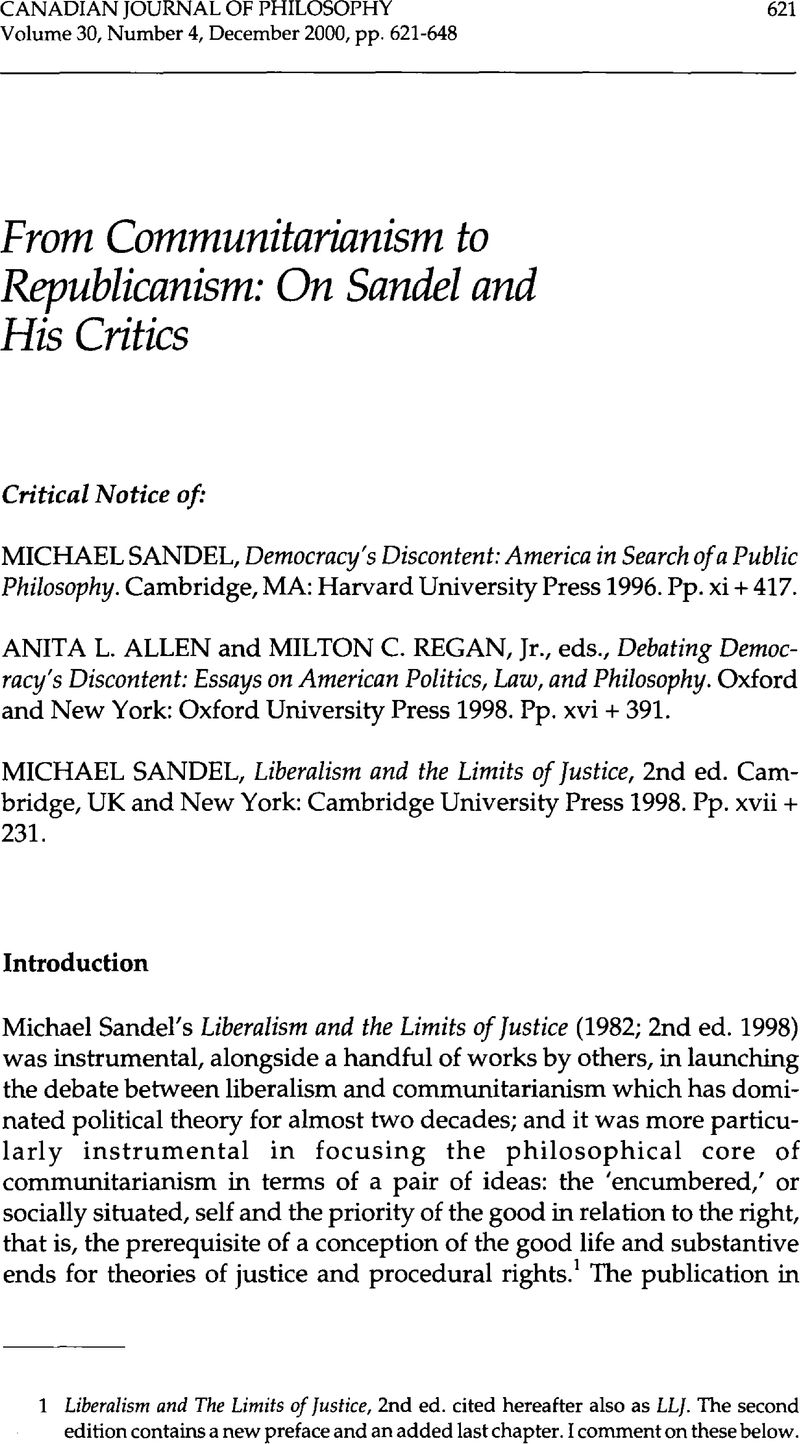Published online by Cambridge University Press: 01 January 2020

1 Liberalism and The Limits of Justice, 2nd ed. cited hereafter also as LLJ. The second edition contains a new preface and an added last chapter. I comment on these below. For an account of the indicated debate and its main figures, see Mulhall, S. and Swift, A. Liberals and Communitarians, 2nd ed. (Cambridge, MA: Blackwell 1996)Google Scholar.
2 Democracy's Discontent: America in Search of A Public Philosophy cited hereafter also As DD.
3 Debating Democracy's Discontent cited hereafter also as DDD. (A number of the essays derive from a symposium held at Georgetown University in April1997.)
4 The theory of (civic) republicanism is now much in vogue, and the subject of a large literature pro and con. I address the topic only as it arises in Sandel and the indicated critiques; at the same time, I expect my discussion to have some general implications for the topic.
5 Beiner cites ‘Galston's wonderful formulation,’ from his symposium presentation: ‘“the right” is really the liberal conception of the good “that dare not speak its name”’ (DDD, 336n6). Wonderful indeed.
6 See Macintyre, A. ‘A Partial Reply to My Critics,’ in Horton, J. and Mendus, S. eds., After Macintyre (Notre Dame: University of Notre Dame Press 1994), 302Google Scholar. Beiner in DOD also draws attention to this (3).
7 See Dworkin, R. ‘Liberal Community,’ California Law Review 77 (1989) 479–520CrossRefGoogle Scholar, and ‘Foundations of Liberal Equality,’ in Peterson, G. ed., The Tanner Lectures on Human Values XI (Salt Lake City: University of Utah Press 1990)Google Scholar; Kymlicka, W. Liberalism, Community and Culture (New York: Oxford University Press 1986)Google Scholar; and Macedo, S. Liberal Virtues: Citizenship, Virtue, and Community in Liberal Constitutionalism (Oxford: Clarendon Press 1992).Google Scholar
8 Rawls, J. A Theory of Justice (Cambridge, MA: Harvard University Press 1971)Google Scholar, cited hereafter also as TJ; Political Liberalism (New York: Columbia University Press 1996), cited hereafter also as PL.
9 Harvard Law Review 7,107 (1994) 1765-94. Rawls, comments briefly on this review in ‘The Idea of Public Reason Revisited,’ University of Chicago Law Review 64 (1997) 765–807, esp. 802CrossRefGoogle Scholar; reprinted in Rawls, Collected Papers, Freeman, Samuel ed. (Cambridge, MA: Harvard University Press 1999)Google Scholar.
10 See Dworkin, R. Freedom's Law: Tire Moral Reading of The American Constitution (Cambridge, MA: Harvard University Press), 46.Google Scholar
11 Several authors in DOD (e.g., William Connolly and Robin West) criticize Sandel for assuming that homosexual relations must be vindicated by the model of heterosexual ones. In some ways they have a point, but since the object is to secure for the former basic rights and benefits accepted for the latter, Sandel's approach of establishing salient similarities is strategically sound and in the needed degree not illegitimate it seems to me.
12 Clifford Orwin in DOD aptly writes: ‘Only a liberal could regard this liberalism as something that we have chosen and that we are therefore free to reject. Paradoxically, to disown the individualist strain of our tradition would itself amount to a declaration of unencumberedness’ (90).
13 Thornton v. Caldor, Inc., 474 U.S. 703 (1985)
14 See Wood, G. The Creation of The American Republic 1776-1787 (New York: W.W. Norton 1960)Google Scholar and Rakove, J.N. Original Meanings: Politics and Ideas in the Making of the Constitution (New York: Alfred A. Knopf 1996), esp. chapters 3, 7, 10.Google Scholar
15 C. Orwin (DDD, 88) stresses the problem in Sandel's seeking political decentralization while also wanting to limit corporate power and social inequality.
16 J. Waldron nicely makes the point that Sandel's whole argument is in effect a refusal to take seriously Constant's case that the liberty of the moderns is not that of the ancients, and more especially that Sandel fails to see that the changed conditions make for very different political virtues. (See DDD, 35-9.) Sandel's last-minute concession about multiply-situated selves confirms Waldron's point.
17 The lodged-in-the-heads view I associate more with Rawls and his presumption that people carry around ‘comprehensive conceptions of the good.’ Against that view I offer this small anecdote concerning a question the journalist James Reston once put to President Kennedy, and the reaction to it. Reston ‘asked the newly elected President what his philosophy was, what vision did he have of the good life. Mr. Reston got a blank stare for an answer.’ See Vidal, Gore ‘The Holy Family’ in United States: Essays 1952-1992 (New York: Knopf 1993), 821Google Scholar. There was also of course President George Bush (not to mention his progeny) who confessed to lacking ‘that vision thing.’
18 For a version of liberalism acknowledging fundamental disagreements and stressing consequent accommodations (a version different from the precedent-based one I have indicated), see Gutman, and , Thompson Democracy and Disagreement (Cambridge, MA: Harvard University Press 1996)Google Scholar.
19 I actually have qualms about that Humboldtian idea as opposed to the more individualistic Millean version of it wherein the different achievements are treated as models and examples.
20 I am grateful to an anonymous referee of this journal for comments on an earlier draft.